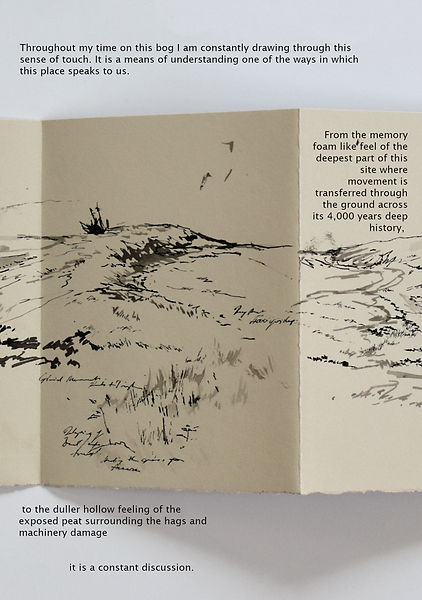
A Crichton Carbon Centre Project
Connecting and Re-Connecting People to Peatlands
Through Art & Science Approaches
Let’s begin at the beginning…
SOIL
That precious stuff beneath our feet that supports
life on earth.

PEAT
A dark, squadgy, organic, waterlogged, anaerobic, acidic, carbon storing soil.

PEAT MAKES PEATLANDS
AND
PEATLANDS MAKE PEAT
Peatlands, bogs, and mires are unique wet landscapes. The plants that grow on peatlands: sphagnum mosses, cotton grasses, sundews, bog asphodel, bog cranberry, form a low-lying carpet of vegetation. This interwoven living carpet of plants absorbs carbon dioxide (CO2) from the atmosphere, which becomes locked as carbon into their cell structures. As the plants die, but not fully decay, peat forms and the carbon in their cells becomes locked into the earth.

Our peatlands have been gradually forming since our last ice age, taking years to form millimetres.
The thick layer of vegetation and organic matter protects the peat forming system beneath, keeping things wet and acidic, physically holding peat in place and protecting it from rain, wind, and ice erosion.

60% OF THE UK’S PEATLANDS ARE IN SCOTLAND
Many of Scotland’s peatlands are scored with artificial drains.

Drainage disrupts the natural hydrology, drying out the land, which ultimately degrades the peatland, its flora and fauna, and can lead to peat erosion.
What were once inconspicuous drains can erode into huge gullies, metres deep, releasing thousands of years of carbon back into the atmosphere.


This is where the Crichton Carbon Centre come in.

Keeping Carbon Where It Belongs
Our Goals
Saving the Carbon in Peatland Carefully
Balancing People & Environment Collaboratively
Exchanging Knowledge Respectfully
Educating People Creatively
Researching for Action Pragmatically
Building Natural Capital Continually
Spreading Good Practice Effectively
Valuing Ecosystems Fairly
Stabilising eroding peat, and raising the water table, are the single most important actions to reduce carbon loss from our peat soils.

We need to manage and restore our peatlands carefully to keep their hydrology intact.

Raised hags created through erosion are levelled,
drainage diches are blocked to re-wet the peat,
and bare peat is held in place using geo-textile.

Climate Changes in Scotland including hotter, drier, weather, storms, and rainfall deluges are contributing to increased erosion on bare, exposed peat.

Aware of Climate Changes
Aware of Climate Crisis
Aware of Soil Crisis
What steps can we take to
Repair our Peatlands
and
Raise Awareness

Art, like science, sheds light on the world around us.
Combining art with science can reach out to and engage with wider and more diverse audiences.

This is exciting!
Art offers another way of grappling with environmental issues and complexities and
re - presents landscapes.

CCC Peatland Collection Eco-garment Residency
Morag Macpherson, 2023
Shot of “Sunken Cloth”
Photo: Duncan Ireland

Stuart Mugridge, 2023
CCC Water Cycle Artist in Residence

Evangeline Morris, 2023
CCC Upper Urr Artist in Residence
WE CONSTANTLY ASK OURSELVES
What projects, research, actions, experiments, initiatives can we enact and deliver that enable us to tackle ecological issues and Climate Crises?
What role do we play in ensuring that all citizens have the power to act for a sustainable future?
What steps can we take that help us meet the challenges of Climate Crisis?

Keeping Carbon Where It Belongs
Our Goals
Saving the Carbon in Peatland Carefully
Balancing People & Environment Collaboratively
Exchanging Knowledge Respectfully
Educating People Creatively
Researching for Action Pragmatically
Building Natural Capital Continually
Spreading Good Practice Effectively
Valuing Ecosystems Fairly



